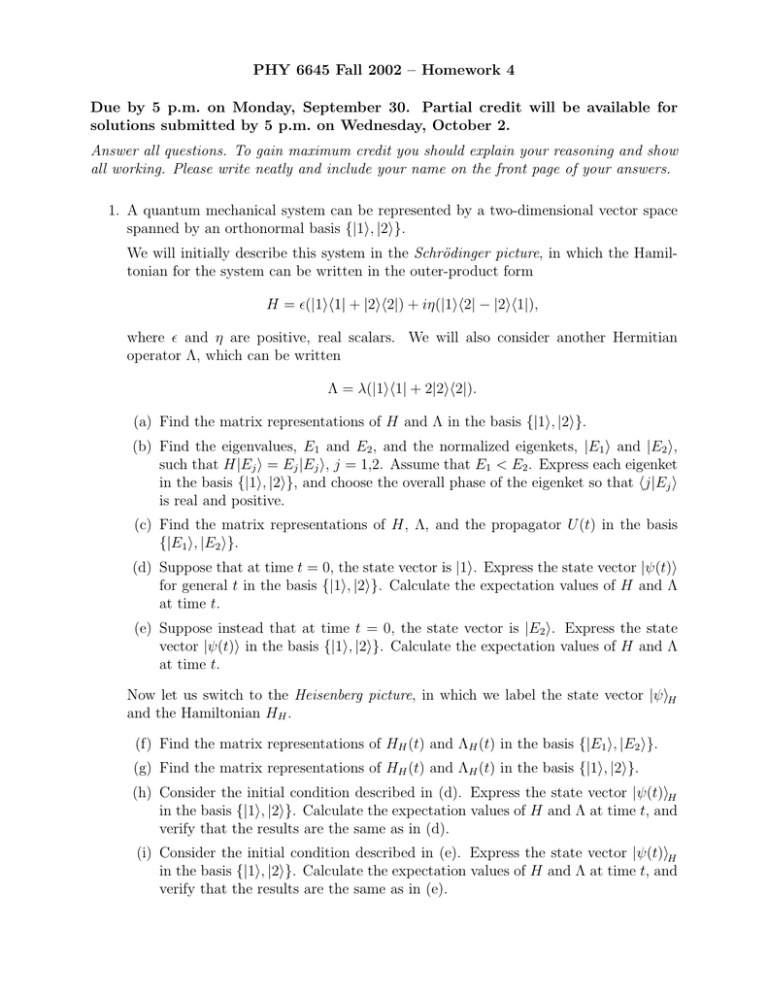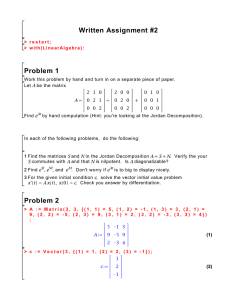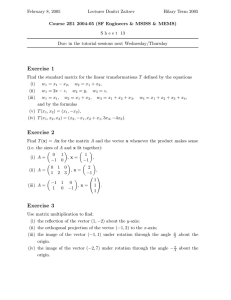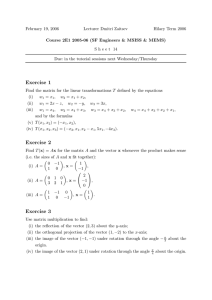PHY 6645 Fall 2002 – Homework 4
advertisement

PHY 6645 Fall 2002 – Homework 4
Due by 5 p.m. on Monday, September 30. Partial credit will be available for
solutions submitted by 5 p.m. on Wednesday, October 2.
Answer all questions. To gain maximum credit you should explain your reasoning and show
all working. Please write neatly and include your name on the front page of your answers.
1. A quantum mechanical system can be represented by a two-dimensional vector space
spanned by an orthonormal basis {|1i, |2i}.
We will initially describe this system in the Schrödinger picture, in which the Hamiltonian for the system can be written in the outer-product form
H = (|1ih1| + |2ih2|) + iη(|1ih2| − |2ih1|),
where and η are positive, real scalars. We will also consider another Hermitian
operator Λ, which can be written
Λ = λ(|1ih1| + 2|2ih2|).
(a) Find the matrix representations of H and Λ in the basis {|1i, |2i}.
(b) Find the eigenvalues, E1 and E2 , and the normalized eigenkets, |E1 i and |E2 i,
such that H|Ej i = Ej |Ej i, j = 1,2. Assume that E1 < E2 . Express each eigenket
in the basis {|1i, |2i}, and choose the overall phase of the eigenket so that hj|Ej i
is real and positive.
(c) Find the matrix representations of H, Λ, and the propagator U (t) in the basis
{|E1 i, |E2 i}.
(d) Suppose that at time t = 0, the state vector is |1i. Express the state vector |ψ(t)i
for general t in the basis {|1i, |2i}. Calculate the expectation values of H and Λ
at time t.
(e) Suppose instead that at time t = 0, the state vector is |E2 i. Express the state
vector |ψ(t)i in the basis {|1i, |2i}. Calculate the expectation values of H and Λ
at time t.
Now let us switch to the Heisenberg picture, in which we label the state vector |ψiH
and the Hamiltonian HH .
(f) Find the matrix representations of HH (t) and ΛH (t) in the basis {|E1 i, |E2 i}.
(g) Find the matrix representations of HH (t) and ΛH (t) in the basis {|1i, |2i}.
(h) Consider the initial condition described in (d). Express the state vector |ψ(t)iH
in the basis {|1i, |2i}. Calculate the expectation values of H and Λ at time t, and
verify that the results are the same as in (d).
(i) Consider the initial condition described in (e). Express the state vector |ψ(t)iH
in the basis {|1i, |2i}. Calculate the expectation values of H and Λ at time t, and
verify that the results are the same as in (e).
Finally, let us switch to the interaction picture, based on a decomposition of the
Schrödinger-picture Hamiltonian into an unperturbed part
H (0) = (|1ih1| + |2ih2|)
and an interaction term
H (I) = iη(|1ih2| − |2ih1|).
In this picture, we label the state vector |ψiI and the Hamiltonian HI .
(j) Find the matrix representation of HI (t) and ΛI (t) in the basis {|E1 i, |E2 i}.
(k) Find the matrix representation of HI (t) and ΛI (t) in the basis {|1i, |2i}.
(l) Consider the initial condition described in (d). Express the state vector |ψ(t)iI in
the basis {|1i, |2i}. Calculate the expectation values of H and Λ at time t, and
verify that the results are the same as in (d).
(m) Consider the initial condition described in (e). Express the state vector |ψ(t)iI in
the basis {|1i, |2i}. Calculate the expectation values of H and Λ at time t, and
verify that the results are the same as in (e).
Note that in all three pictures, the basis vectors (|1i and |2i, or |E1 i and |E2 i) are
assumed to be independent of time.
2. Consider the system from Problem 1, with the initial state described in 1(d). Use the
state-operator formalism (working in the Schrödinger picture) to find . . .
(a) the state operator ρ(t = 0) as an outer product;
(b) the density matrix ρ(t = 0) in the basis {|1i, |2i};
(c) the density matrix ρ(t = 0) in the basis {|E1 i, |E2 i};
(d) the density matrix ρ(t) in the basis {|E1 i, |E2 i};
(e) the density matrix ρ(t) in the basis {|1i, |2i};
(f) the expectation values of H and Λ at time t, and verify that the results are the
same as in 1(d).
3. Once again, consider the system from Problem 1 using the state-operator formalism.
Consider, in turn, three different initial conditions:
(a) ρ(t = 0) = a|1ih1| + (1 − a)|2ih2|,
(b) ρ(t = 0) = a|1ih1| + (1 − a)|E2 ihE2 |,
(c) ρ(t = 0) = 12 (|1ih1| − |1ih2| − |2ih1| + |2ih2|),
where a is a real scalar satisfying 0 < a < 1.
For each initial condition, . . .
(i) determine whether the initial state is pure or mixed, and if it is pure, find the
corresponding state vector |ψ(t = 0)i;
(ii) construct the density matrix ρ(t) in the basis {|1i, |2i};
(iii) calculate the expectation values of H and Λ at time t.




